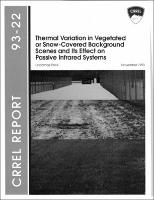Please use this identifier to cite or link to this item:
https://hdl.handle.net/11681/9172Full metadata record
| DC Field | Value | Language |
|---|---|---|
| dc.contributor | United States. Air Force. Electronic Security and Communications Center for Excellence | - |
| dc.contributor.author | Peck, Lindamae | - |
| dc.date.accessioned | 2016-06-20T13:40:34Z | - |
| dc.date.available | 2016-06-20T13:40:34Z | - |
| dc.date.issued | 1993-11 | - |
| dc.identifier.uri | http://hdl.handle.net/11681/9172 | - |
| dc.description | CRREL Report | - |
| dc.description | Abstract: The diurnal and seasonal variations in the magnitude of and rate of change of surface temperature have been investigated for vegetated and snow-covered ground under winter, summer and transitional weather conditions at a site in Vermont. The variability in thermal radiance is evident as changes in the proximity-to-alarm status of passive infrared detection systems. A mid-winter snow cover is the most favorable background because its associated thermal radiance changes are less dynamic than are the radiance changes of uniform grass covers in summer or mixed backgrounds of grass—thatch—soil following winter. Grass—thatch—soil backgrounds typically experience a larger diurnal range in temperature (from nighttime low to daytime high) and greater spatial variability in thermal radiance than do the uniform grass covers. The summer grass is more likely to be long enough to blow in the wind, thereby causing a change in thermal radiance as variously the sun-warmed, upper portion of the grass blades or the shaded (and therefore cooler) basal portion of the grass blades, and perhaps the sheltered soil, are momentarily exposed to the passive infrared system. | - |
| dc.publisher | Cold Regions Research and Engineering Laboratory (U.S.) | - |
| dc.publisher | Engineer Research and Development Center (U.S.) | - |
| dc.relation | http://acwc.sdp.sirsi.net/client/en_US/search/asset/1001303 | - |
| dc.relation.ispartofseries | CRREL report ; 93-22. | - |
| dc.rights | Approved for public release; distribution is unlimited. | - |
| dc.source | This Digital Resource was created from scans of the Print Resource | - |
| dc.subject | Detection capability | - |
| dc.subject | Environmental effects | - |
| dc.subject | Intrusion detection | - |
| dc.subject | Passive infrared sensors | - |
| dc.subject | Perimeter security | - |
| dc.subject | Sensors | - |
| dc.subject | Infrared detectors | - |
| dc.subject | Thermal properties | - |
| dc.title | Thermal variation in vegetated or snow-covered background scenes and its effect on passive infrared systems | - |
| dc.type | Report | en_US |
| Appears in Collections: | CRREL Report | |
Files in This Item:
| File | Description | Size | Format | |
|---|---|---|---|---|
| CRREL-93-22.pdf | 658.56 kB | Adobe PDF |  View/Open |